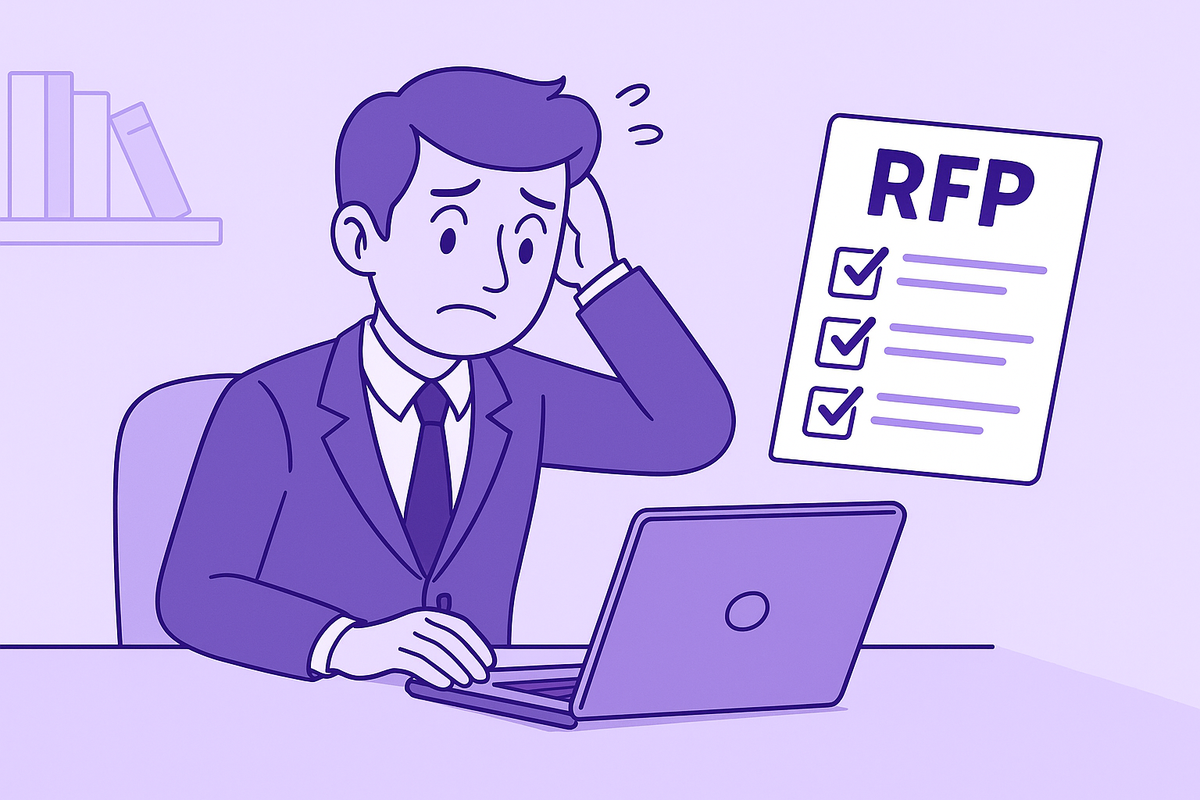Writing high-quality proposals is time-consuming and often requires tracking down the right documents, past answers, and certifications under tight deadlines. That leads to rushed drafts, inconsistent claims, and missed opportunities. AI changes this by reading your source files, matching questions to verified answers, and producing a contextual draft that your experts can refine.
A practical example is an ai rfp platform that connects your knowledge sources and speeds first drafts while keeping answers traceable to evidence.
In this blog, we’ll define what an AI RFP system actually does, explain the main technical ideas behind it, list the features that matter for mid-market and enterprise teams, and give a short rollout checklist you can use right away.
What Does an AI RFP Mean
An AI RFP system uses machine learning and natural language tools to read incoming RFPs, find the requirements, then pull and assemble the most relevant content from your internal documents and past responses. The result is a draft that reduces manual copy-paste work and points reviewers to the exact evidence behind each claim. This is not a magic writer that replaces experts; it’s a drafting assistant that gives your team a reliable starting point.
Next, we’ll look at the core technology that makes this possible.
Core Technologies Behind AI-Driven RFP’s
Learn how it works so you can evaluate vendors effectively.
- Semantic search and embeddings: convert questions and documents into vector representations so the system can match meaning, even when wording differs.
- Retrieval-Augmented Generation (RAG): the platform retrieves supporting passages from your verified content store and then uses a language model to craft a concise answer that cites that material. This keeps outputs grounded in your data rather than generic web text.
- Governed answer libraries: approved, versioned responses that the AI can reuse; these are managed so only current, signed-off language is suggested.
- Integrations and connectors: links to Google Drive, SharePoint, Confluence, and other systems so the AI has a single, searchable source of truth.
With the technical picture in mind, let’s review practical benefits that matter to you.
Why This Matters for Mid-Market and Enterprise Teams
You care about speed, accuracy, and auditability. An AI RFP approach addresses those needs by moving the heavy lifting into a controlled system and freeing subject experts to review and personalize answers.
Many procurement leaders are already taking action, as 92% said they are planning or assessing generative AI in 2024.
Quick Benefits:
- Faster first drafts: teams report large cuts in draft time when the platform auto-populates common questions.
- Better consistency: governed libraries reduce conflicting statements across sections.
- Early gap detection: mapping shows missing documents or compliance items before submission.
- Capacity scaling: your proposal team can handle more opportunities without adding headcount.
Beyond benefits, look for specific features when comparing platforms.
Features to Require When Evaluating Vendors
Practical capabilities that reduce risk:
- A centralized knowledge hub with version control and role-based access.
- Semantic search combined with RAG helps ground answers in your documents.
- Requirement-to-evidence mapping (matrix view) enables reviewers to verify each claim quickly.
- Audit logs and change history for compliance and post-mortem reviews.
- Connectors to your document stores and single-sign-on for secure access.
What to Check In Short Form:
- Does the vendor keep a clear provenance trail for each suggested answer?
- Can you restrict which content the model may access during generation?
- Are exports available in the submission formats you need (Word, PDF, portal upload)?
These controls reduce risk, but no system is without hazards, so don’t skip guardrails.
Managing Risks and Implementing Practical Guardrails
Treat AI as a tool that needs limits.
- Data leakage: avoid sending sensitive customer information to public models; prefer platforms that run on private instances or white-listed APIs.
- Stale content: Establish a content review cadence to ensure the answer library reflects current architecture, certifications, and SLAs.
- Overreliance on auto-drafts: requires subject expert sign-off on legal or security statements.
- Auditability: keep the provenance record so you can show exactly where each statement came from during buyer diligence.
With risks covered, here is a simple rollout path you can follow.
A Practical Rollout Path
Adopt in focused steps for measurable wins.
- Run a pilot with one sales or solutions team and a limited content set (product briefs, compliance docs).
- Build or migrate a small, governed answer library and set read/edit roles.
- First, measure the time saved by reviewers in drafting, then expand to more teams and integrations.
- Add automated checks for expired certifications and broken links.
Quick Checklist for Launch:
- Identify two data sources to connect first (example: SharePoint and past RFPs).
- Set a monthly content review owner.
- Define sign-off rules for legal and security language.
- Track time saved and re-use rates to justify expansion.
Once in production, continue to improve the library and governance to preserve accuracy.
Conclusion
AI RFP systems are tools that shift effort from manual drafting to higher-value review and strategy. For technology, cybersecurity, and SaaS vendors facing complex, evidence-driven buying processes, a governed AI approach cuts repetitive work, keeps answers consistent, and highlights missing compliance items early.
Start small, require human review where it matters, and maintain clear records of every answer that will enable faster responses without increasing risk. If you want to see a working example, the linked platform in the introduction demonstrates a live approach to these challenges.

